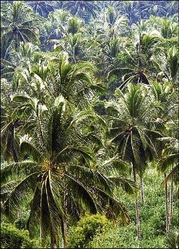'Alien' threat - Invasive organisms pose risk to biodiversity
Published: Wednesday | May 20, 2009

Coconut trees in Bog Walk, St Catherine. The limited success of Jamaica's coconut replantation programme, which was launched in 2000, has been linked to mite infestation. - Ricardo Makyn/Staff Photographer
Environmental groups in Jamaica are seeking to raise public awareness about the threat of invasive alien species, as well as to encourage action to tackle related problems.
Jamaica is among 191 countries which are party to the Convention on Biological Diversity which will be hosting activities in observance of International Biodiversity Day on Friday. This year's theme is 'Invasive Alien Species (IAS) - One of the Greatest Threats to Biodiversity, and to the Ecological and Economic Well-being of the Society and Planet'.
The island has rich biodiversity, including a variety of plants, animals, organisms and types of environ-ments. As an island, Jamaica is vulnerable to invasive alien species because of its small size and geographic isolation.
Islands have high endemism (plants, animals and organisms only found there), small habitat range and unique types of environments which were developed over millions of years in the absence of these invasive species. The introduction of invasive alien species, therefore, often have a negative impact.
Alien species are animals, plants and other organisms that are not native to the environment, and have been introduced either intentionally or unintentionally.
When an alien species poses a threat to other organisms in the environment, it is referred to as an invasive alien species. Invasive alien species may cause the decline or elimination of other species through predation, competition for food and habitat, and the transmission of diseases. They may also affect the economy in cases where native species are harvested commercially. However, it is important to note that the labelling of a species as alien or invasive is specific to a particular country. Species that are alien in one country may be native to another, and species that are invasive in one country may pose no threat in another.
Jamaica's invasive alien species include the Small Indian Mongoose (Herpestes javanicus), White-tailed deer (Odocoileus virginianus), and Mock Orange (Pittosporum undulatum), a plant.
The Small Indian Mongoose is believed to have contributed to the possible extinction of two of Jamaica's endemic birds, the Jamaica Petrel (Pterodroma caribbaea) and Jamaican Paruraque (Siphonorhis americana). It is also a threat to the endemic Jamaican Iguana (Cyclura collei).
Contributed by members of the International Biodiversity Day committee - Institute of Jamaica, National Environment and Planning Agency, Office of the Prime Minister.
The Convention on Biological Diversity
The Convention on Biological Diversity was established at the Rio Earth Summit in 1992. Countries that are party to the convention have agreed to prevent the introduction, control and eradication of invasive alien species. In Jamaica, the Alien Invasive Species Working Group, for which the National Environment and Planning Agency is the secretariat, provides assistance to ensure that the island fulfils obligations under the convention.








